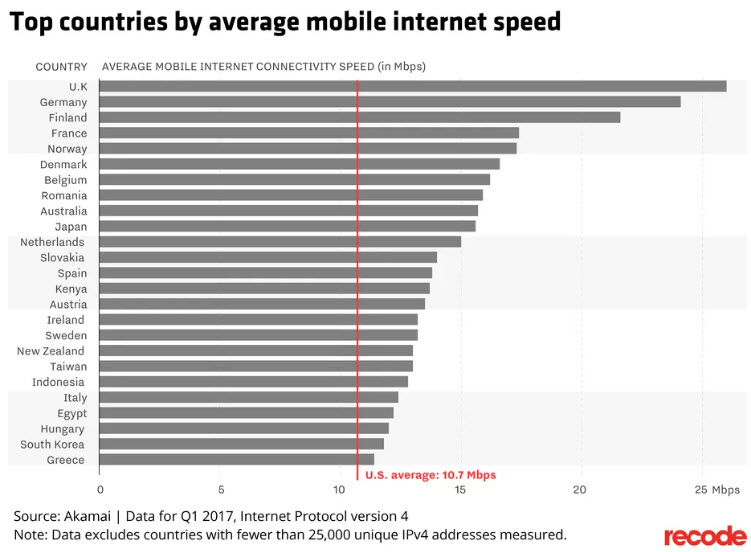
How To Stay Connected As You Travel In Europe
This post gives you tips on how to stay connected in Europe without it costing you a bundle. We discuss the benefits of using a local SIM card in your phone and tell you where to go to access free Wifi connections.
Wifi in Europe compared to the US/Canada
In 2017, Akamai Technologies, a US-based content delivery company, released a ranking of countries with the fastest mobile internet speeds. The U.K., Germany, and Finland led the pack. In fact, eight of the top 10 countries were in Europe. The United States came in 28th and Canada was just below that. Slower than Kenya (14th, and yes, I know it’s not in Europe). Slower even than Hungary (23rd) and Greece (25th).

Mobile internet speeds graphic (recode.com)
To read an interesting and informative summary of the Akamai report, refer to the following article at recode.com, which is where the graph above originally appears. The U.S. ranks 28th in the world in mobile internet speeds.
Which is to say that, on average, the internet you access in Europe is going to be faster and better than you’re used to if you’re from North America. The key is in gaining access to it and not getting financially ruined in the process.
The first section of this blog explains roaming in Europe: how it’s charged if you’re using a European phonecard versus one from outside Europe. The remaining sections focus on what you can expect to find when accessing wifi in public. If you’ve got any comments, corrections, or relevant anecdotes, let us know in the Comments section below.
European SIM Cards
If your non-European phone is unlocked, the best thing to do is buy a SIM card when you arrive in Europe and swap it in. In general, SIM card plans are fairly cheap throughout Europe; certainly cheaper than paying roaming charges. And you’ll have no trouble finding places that sell the cards. Branded phone stores are extremely common in Europe and the SIMs are also sold at most news agents, tobacconists, and grocery stores.
The benefit of a local SIM card is that they provide you with a local number. This makes it cheaper and easier to make and receive calls and use mobile internet during your stay. There are a huge number of network carriers available, but the two with the widest reach and the most stores are Orange and Vodafone. Expect to pay about $25–$35 (U.S.) for a comprehensive, though not necessarily unlimited, “messaging, internet, and calling” plan good for 30 days or so.
Roaming Charges
If you’re not from Europe, before logging into any European networks (or any country’s internet network), make sure you’ve got Mobile Data turned off on your phone OR that your mobile plan covers international access. Failure to do so could cost you a huge amount of money.
Note that if you’re using a phone plan/SIM purchased in a country that’s part of the European Union, you’re golden. As of June 2017, European phone companies are not permitted to charge extra for roaming. This covers all calls, SMS messages, and internet usage made by travelers in the European Union while using a European phone. So, if you buy an Irish SIM card, for example, you can use your phone in France and all of your calls, messages, and internet usage will be billed as if you were in Ireland.
Wifi Availability
Cafes
Unlike a lot of places in the United States, almost every cafe, restaurant, and public network in Europe requires you to log in with a password. Or they request that you use your Facebook or Google credentials to gain access. In fairness to the Europeans I’ve dealt with, none has ever refused or even acted unfriendly when I’ve asked for the password. So it’s a minor nuisance at worst.
Public Transportation
A lot of countries in Europe claim to offer wifi onboard their buses and trains. That’s not always true or not always the whole truth. In the six years I’ve been living and traveling in Europe I would estimate the wifi on buses and trains has worked about 50% of the time. And when it does work, some systems allow you only a tiny amount of data for free. The result is that you really can’t use it to do anything other than check email. So don’t expect to be able to use Netflix streaming to while away the hours.
Some countries, like Italy, offer wifi only on the more upscale (i.e. expensive) trains. The huge caveat here is that in exchange for access, they want all of your details. For Tren Italia, you must provide a valid email address and phone number as well as your credit card number and its CVV (PIN number). They won’t charge your credit card any money. In fact, they claim that it’s just a way of proving that you are who you say you are. In theory, Tren Italia then sends a text message to your phone that grants you access to their network. For overseas visitors, then, the impact is doubly negative. You end up with a stiff roaming fee for the text message and the Italian rail service ends up with a lot of details about you.
The last two times I rode the Italian rail system, I provided all of the required information repeatedly. Each time I got a different error message or was sent back to a previous screen. In the end, I gave up in frustration and just stared out the window, which wasn’t a bad alternative. Keep the possibility of connection issues in mind when planning how to keep yourself entertained while on the go.
Hotels
In general, you can expect to find free, unlimited high-speed wifi in most hotels in Europe. When I first moved here six years ago, it wasn’t uncommon to find hotels that charged exorbitant rates for wifi. Or that had no wifi at all. In fact, on separate trips to Florence, staff at two different mom-and-pop hotels told me that their wifi was down due to lightning strikes!
Nowadays, though, the pressures of competition in the hospitality industry and the widespread availability of wifi services means that it’s become more or less standard.
Note, though, that some higher-end hotel chains still try a bait-and-switch approach. NH hotels in Malaga, Amsterdam, and Berlin, at least, offer “free wifi” to all guests. But they don’t tell you it’s a limited version. In fact, it’s so slow, it’s only good for checking email. If you need high-speed wifi, you’ll need to shell out a lot of money each day. In Malaga, it was 12 euros/day and in Amsterdam it was nearly 10. If or when this changes, I’ll update this post.
To see if the hotel you’re considering has truly free and usable wifi, there’s no better resource than the customer review section of TripAdvisor.com. Just make sure you’re reading recent comments, not ones from 8 or 10 years ago. Things change quickly in terms of internet accessibility, so 8 years is practically a lifetime.
Related Posts
If you liked this post, check out some of our other related articles: